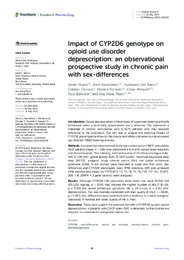Abstract:
ntroduction: Opioid deprescription is the process of supervised tapering and safe withdrawal when a potentially inappropriate use is detected. This represents a challenge in chronic non-cancer pain (CNCP) patients who may respond differently to the procedure. Our aim was to analyze the potential impact of CYP2D6 phenotypes and sex on the clinical and safety outcomes during an opioid use disorder (OUD) tapering process. Methods: A prospective observational study was conducted on CNCP ambulatory OUD patients (cases, n = 138) who underwent a 6-month opioid dose reduction and discontinuation. Pain intensity, relief and quality of life (Visual analogue scale, VAS 0-100 mm), global activity (GAF, 0-100 scores), morphine equivalent daily dose (MEDD), analgesic drugs adverse events (AEs) and opioid withdrawal syndrome (OWS, 0-96 scores) were recorded at basal and final visits. Sex differences and CYP2D6 phenotypes (poor (PM), extensive (EM) and ultrarapid (UM) metabolizers based on CYP2D6*1, *2, *3, *4, *5, *6, *10, *17, *41, 2D6*5, 2D6 × N, 2D6*4 × 2 gene variants) were analyzed. Results: Although CYP2D6-UM consumed three-times less basal MEDD [40 (20-123) mg/day, p = 0.04], they showed the highest number of AEs [7 (6-11), p = 0.02] and opioid withdrawal symptoms (46 ± 10 scores, p = 0.01) after deprescription. This was inversely correlated with their quality of life (r = -0.604, p < 0.001). Sex-differences were evidenced with a tendency to a lower analgesic tolerability in females and lower quality of life in men. Discussion: These data support the potential benefits of CYP2D6-guided opioid deprescription, in patients with CNCP when OUD is detected. Further studies are required to understand a sex/gender interaction.
|

.png)
